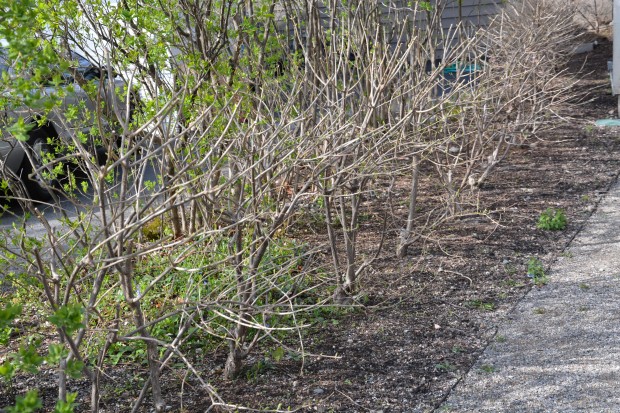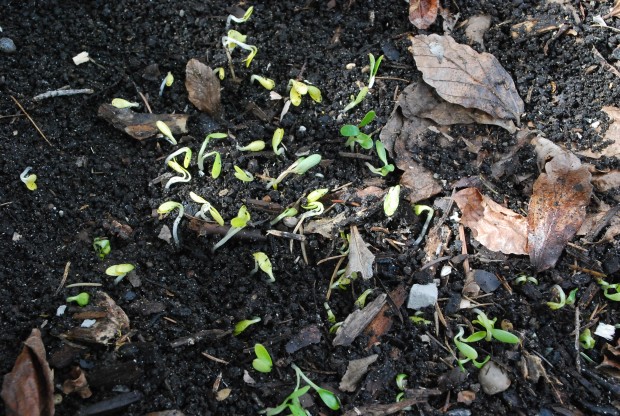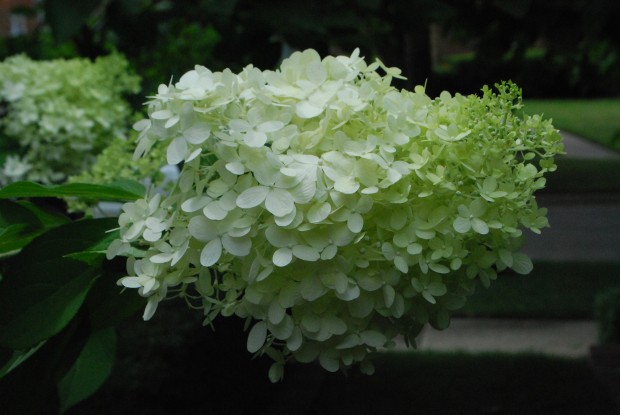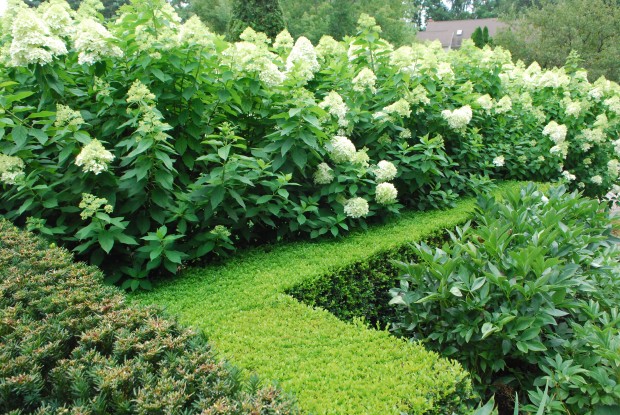 The best time to prune deciduous shrubs is whenever you have the time available to prune. But no doubt some pruning dates are better than others. Late March is the perfect time time in my zone, provided the ground is dry enough be walked on. The bare branches make it easy to spot what is dead or weak. Or which cuts would result in a better looking or more graceful shape. In general, the shag haircut theory of pruning promotes good shrub health. Big at the bottom, and narrower at the top. Pruning such that no two branches are the same height or forced to occupy the same space helps to insure that every bud ready to leaf out will have its own light and air space. A place to grow without interference is an ideal place for a branch to be. I like to leave the branches near the ground long, and the branches on the top shorter. Visualizing what has to be cut back on the top so the lower branches get the light they need will result in a shrub that is green and growing from top to bottom. If you think the Limelight hydrangeas above do not look like I took my own advice, you are right.
The best time to prune deciduous shrubs is whenever you have the time available to prune. But no doubt some pruning dates are better than others. Late March is the perfect time time in my zone, provided the ground is dry enough be walked on. The bare branches make it easy to spot what is dead or weak. Or which cuts would result in a better looking or more graceful shape. In general, the shag haircut theory of pruning promotes good shrub health. Big at the bottom, and narrower at the top. Pruning such that no two branches are the same height or forced to occupy the same space helps to insure that every bud ready to leaf out will have its own light and air space. A place to grow without interference is an ideal place for a branch to be. I like to leave the branches near the ground long, and the branches on the top shorter. Visualizing what has to be cut back on the top so the lower branches get the light they need will result in a shrub that is green and growing from top to bottom. If you think the Limelight hydrangeas above do not look like I took my own advice, you are right.
 There is a story behind these leggy Limelights. Planted as a 5 plant by 5 plant block of 25 some 12 years ago, they had overgrown their space. The lesson here? A shrub that will grow 6 feet tall by 6 feet wide probably will top out at 8′ by 8′ left to its own devices. Keeping a plant smaller than its genetically determined size is, over time, a losing battle. My 25 plants had become a single organism. Removing any of them from the mix would expose a not so lovely look at a dark and bare interior. It was time to take out the outer front and side rows. Once I reduced the size of the block to a four plant by 4 plant block, I could see what I had left over was a mass of hydrangeas on 3′ tall bare stalks. As in, a block of multi-trunked hydrangeas on standard.
There is a story behind these leggy Limelights. Planted as a 5 plant by 5 plant block of 25 some 12 years ago, they had overgrown their space. The lesson here? A shrub that will grow 6 feet tall by 6 feet wide probably will top out at 8′ by 8′ left to its own devices. Keeping a plant smaller than its genetically determined size is, over time, a losing battle. My 25 plants had become a single organism. Removing any of them from the mix would expose a not so lovely look at a dark and bare interior. It was time to take out the outer front and side rows. Once I reduced the size of the block to a four plant by 4 plant block, I could see what I had left over was a mass of hydrangeas on 3′ tall bare stalks. As in, a block of multi-trunked hydrangeas on standard.
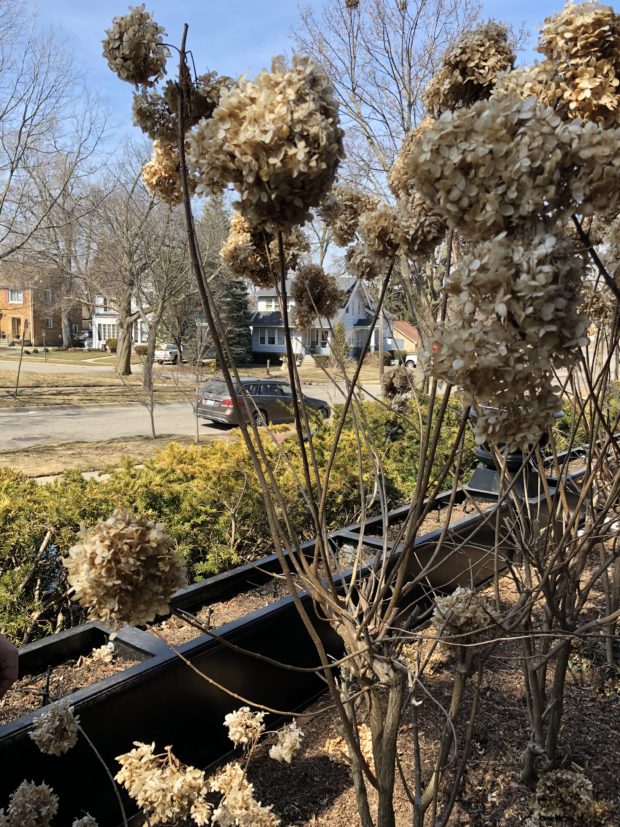 Of course these hydrangeas had gotten leggy in the interior. I am sure no light reached the ground during the summer. The outside rows has been pruned to facilitate growth from top to bottom. The interior shrubs has been pruned to encourage growth on the tops. All very predictable, this. Last spring I planted Little Lime hydrangeas in from of those Limelight legs, thinking this shorter version would create a coverup.
Of course these hydrangeas had gotten leggy in the interior. I am sure no light reached the ground during the summer. The outside rows has been pruned to facilitate growth from top to bottom. The interior shrubs has been pruned to encourage growth on the tops. All very predictable, this. Last spring I planted Little Lime hydrangeas in from of those Limelight legs, thinking this shorter version would create a coverup.
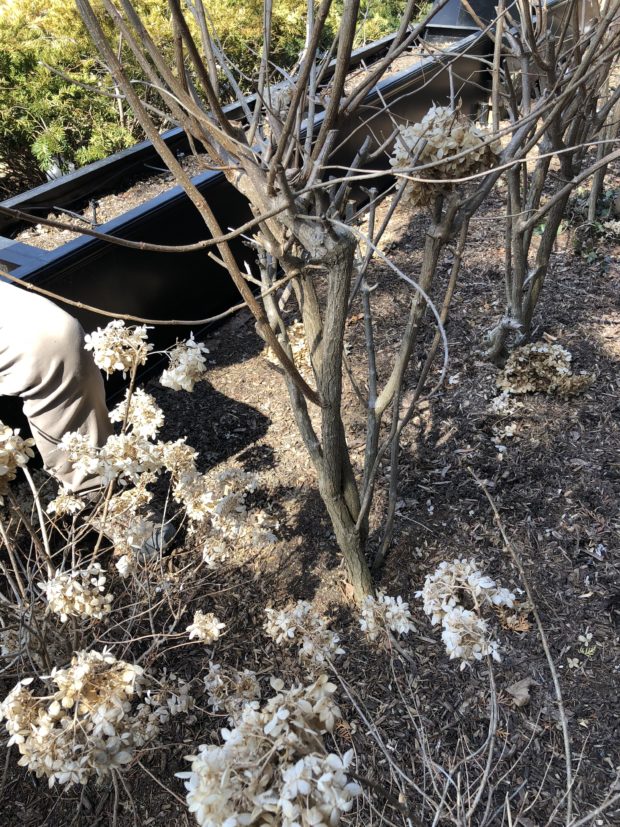 That strategy left more that a little to be desired. Little Lime is by no means a smaller growing version of Limelight. The flowers are a different shape and color. I was not crazy about the two plants side by side. Hydrangea Bobo might have been a better choice. That said, I knew my only real option with the limelights was to take a renovation strategy. Hard pruning old hydrangeas hard is only shocking if you do not take into account how fast and much they grow between April and the late July bloom time. A single branch may grow 3 or 4 feet in one season.
That strategy left more that a little to be desired. Little Lime is by no means a smaller growing version of Limelight. The flowers are a different shape and color. I was not crazy about the two plants side by side. Hydrangea Bobo might have been a better choice. That said, I knew my only real option with the limelights was to take a renovation strategy. Hard pruning old hydrangeas hard is only shocking if you do not take into account how fast and much they grow between April and the late July bloom time. A single branch may grow 3 or 4 feet in one season.
 This is a radical and grim look, but I suspect they will be full of flowers by the beginning of August. How so? The renovation plan calls for a second pruning in June. I am not interested in long single branches with few and hugely ungainly flowers. Cutting back a long branch midway to the bloom time will result in side branching at the cut. This may result in a delayed flowering, but there will be flowers nonetheless. Next year they will regain their fulsome look.
This is a radical and grim look, but I suspect they will be full of flowers by the beginning of August. How so? The renovation plan calls for a second pruning in June. I am not interested in long single branches with few and hugely ungainly flowers. Cutting back a long branch midway to the bloom time will result in side branching at the cut. This may result in a delayed flowering, but there will be flowers nonetheless. Next year they will regain their fulsome look.
 Hydrangeas respond much more quickly to renovation pruning than other less vigorous shrubs. It won’t be long before they start growing out of this.
Hydrangeas respond much more quickly to renovation pruning than other less vigorous shrubs. It won’t be long before they start growing out of this.
 Knowing the best time to prune doesn’t necessarily result in action. I should have pruned these hydrangeas harder last spring, when the extra rows of plants came out. If you are like me, what I need to do in the garden routinely gets away from me. How indulgent hydrangeas are of less than stellar care is just one of the reasons to like them. Pruning times depend on whether they bloom on new or old wood. Since the Limelights bloom on new, or the current season’s growth, no matter how much or how little you prune, you are not removing flower buds. Just buds which will become leaves. So prune away.
Knowing the best time to prune doesn’t necessarily result in action. I should have pruned these hydrangeas harder last spring, when the extra rows of plants came out. If you are like me, what I need to do in the garden routinely gets away from me. How indulgent hydrangeas are of less than stellar care is just one of the reasons to like them. Pruning times depend on whether they bloom on new or old wood. Since the Limelights bloom on new, or the current season’s growth, no matter how much or how little you prune, you are not removing flower buds. Just buds which will become leaves. So prune away.
 Pruning is a paradox. We sometimes prune back shrubs to limit their size, not realizing that a pruning cut, from a shrub’s point of view, is a call to grow. To branch out. A single pruning cut on a large sized branch results in lots of buds breaking in every direction below that cut. This late winter photograph of a hedge in my neighborhood tells the story. A hedge of substantial size was cut back for a number of years-at the height this gardener could reach. The result was lots of branching at the top, which eventually shaded out the branches at the bottom. Once the hedge became too tall to prune without a good sized ladder, the pruning stopped. The result is a rather interesting mix of bare sticks at the bottom, dense branching at the mid level, and long unbranched growth at the top. Add to that mix, some weed trees that got a foothold in the hedge, and have grown to a large size. In this location, a very tall vase shaped hedge is probably a good idea. The traffic on both sides can come in and out the driveways under the umbrella shaped part of the hedge. I will be interested to see the summer look.To prune or not to prune-now is a good time to decide.
Pruning is a paradox. We sometimes prune back shrubs to limit their size, not realizing that a pruning cut, from a shrub’s point of view, is a call to grow. To branch out. A single pruning cut on a large sized branch results in lots of buds breaking in every direction below that cut. This late winter photograph of a hedge in my neighborhood tells the story. A hedge of substantial size was cut back for a number of years-at the height this gardener could reach. The result was lots of branching at the top, which eventually shaded out the branches at the bottom. Once the hedge became too tall to prune without a good sized ladder, the pruning stopped. The result is a rather interesting mix of bare sticks at the bottom, dense branching at the mid level, and long unbranched growth at the top. Add to that mix, some weed trees that got a foothold in the hedge, and have grown to a large size. In this location, a very tall vase shaped hedge is probably a good idea. The traffic on both sides can come in and out the driveways under the umbrella shaped part of the hedge. I will be interested to see the summer look.To prune or not to prune-now is a good time to decide.



